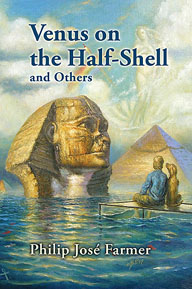
Tell us a little about yourself and how you first discovered Philip José Farmer.
Well, from a young age I've been fascinated by science fiction and fantasy. I started out reading H. G. Wells. I had an omnibus - I think it was simply titled SCIENCE FICTION BY H. G. WELLS - that I devoured when I was in grade school. I also read and enjoyed Jonathan Swift, Jules Verne, and Tolkien at an early age, but it wasn't until I encountered Edgar Rice Burroughs that the dam broke and I knew I had to write. Right after that I discovered Farmer. The first books of his that I read were THE MAKER OF UNIVERSES, HADON OF ANCIENT OPAR, and TARZAN ALIVE, having been drawn to him by the intersection with ERB's worlds in the latter two works. I was spellbound straightaway with how Farmer had taken Burroughs's proclivity for linking his own series together and expanded it, so that all of literature seemed to exist in a meta universe that one could get access to by creative reading. We're so used to hearing the phrase "creative writing," but Farmer initiated his readers into the wondrous secret that reading itself can be an actively creative process. And as I devoured everything of Farmer's that I could find (after reading almost every ERB novel then in print), I was also reading a lot of the authors that influenced Phil, such as Vonnegut, Twain, London, and Doyle.
So I guess because of all of this exposure to the fantastic I ended up a writer and editor of SF/F. In my day job I work as an editor at Paizo Publishing, publisher of the Pathfinder Roleplaying Game and the Planet Stories science fiction and fantasy imprint. In the past few years I've also had some of my short fiction published in anthologies. In my free time I write.
And eventually, I should add, I got to meet and know Phil Farmer and his wife Bette, which I count as one of the great honors and experiences of my life. I was also fortunate to have had the opportunity to edit three Farmer collections for Subterranean Press (UP FROM THE BOTTOMLESS PIT AND OTHER STORIES, VENUS ON THE HALF-SHELL AND OTHERS, and THE OTHER IN THE MIRROR).

Going back a bit, starting in 1996, you wrote a number articles about Farmer's Doc Savage origin story ESCAPE FROM LOKI, which were published in The Bronze Gazette and the anthology MYTHS FOR THE MODERN AGE: PHILIP JOSÉ FARMER'S WOLD NEWTON UNIVERSE. Phil was aware of these articles, you sent him copies, and you even corresponded with him about them. What made you so interested in this story in particular that you chose to examine it so closely?
I forgot - somehow - to add in the answer to the previous question that I obsessively read the Doc Savage series in the Bantam reprints beginning at age fifteen. It took me seemingly forever to track them all down, and I didn't finish reading them all until the 1990s.
In any case, after I read Farmer's ESCAPE FROM LOKI when it came out in 1991, I didn't even pause for a day before I picked it up again and started rereading it. And then I turned around and reread it yet again. Each time I did this, pieces of a Brobdingnagian jigsaw puzzle seemed to fall into place and I quickly became convinced Phil had laid a hidden backstory in the novel that could only be understood by someone who'd read certain of his other works, such as THE OTHER LOG OF PHILEAS FOGG and his Sherlock Holmes/Raffles pastiche, "The Problem of the Sore Bridge - Among Others." One of my ideas was that Phil had taken one of Doc's nemeses from the original Doc Savage pulps and given him a female disguise in ESCAPE FROM LOKI. Phil was genuinely tickled by this when he read the article I'd written on it, comparing it to when Rex Stout scandalized the Sherlock Holmes community by proposing that Watson was a woman. The theory really isn't as far out as it sounds. Anyone who's familiar with the novel VENUS ON THE HALF-SHELL knows to what lengths Phil will go to play the trickster, and the theme of duplicitous sex change does appear elsewhere in Phil's work. Phil said he approved of my way of thinking.
This leads us to one of the main reasons we were eager to interview you. Do you think all this attention to detail contributed to Phil allowing you to complete the third, and concluding, novel in the Khokarsa series (the first two novels being HADON OF ANCIENT OPAR and FLIGHT TO OPAR)?
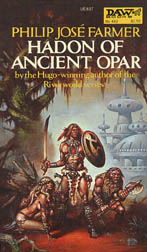
I think it was probably a big factor, yes. He knew I wasn't just familiar with his own body of work, but also that I had a deep appreciation of the Burroughs and Haggard traditions that inspired the series. He also knew I had a degree in anthropology - one of his great lifelong interests - and was then working on my Master's in writing. By this time, Phil had stopped writing and was long into his retirement. But I think it nagged at him that the Khokarsa series was left unfinished, and when the original manuscript fragment and outline he'd written for the third novel turned up, I think he and Bette felt the stars had finally aligned. For myself, I was astounded, thrilled, and humbled all at once to be able to help complete the trilogy.
Without revealing any spoilers, what's the novel about?
It's the story of the giant Kwasin's return to the civilization of Khokarsa after eight long years of exile in the Wild Lands. But on his return, Kwasin discovers that King Minruth has overthrown Khokarsa's matriarchy and seized control of the empire. Kwasin wants take up the fight against Minruth, but first he has to clear his name with the woman he wronged and the oracle who cast him out because of it. The novel picks up right after the events of HADON OF ANCIENT OPAR, when Kwasin is last seen wielding his great ax in an epic battle with Minruth's soldiers, remaining behind to give his cousin Hadon and his companions a chance to escape.
Where did the title THE SONG OF KWASIN come from?
The novel outline by Phil that I worked from was originally titled "KWASIN OF OPAR," but Phil was never really happy with the title since Kwasin was from Dythbeth, not Opar, and also because the novel is chiefly set on the island of Khokarsa, not in distant Opar. So when the chance to complete the novel surfaced, so did the opportunity to retitle it. "KWASIN OF DYTHBETH" (pronounced "Deeth-bayth" in Khokarsan) was too much of a mouthful, so we went for something that evoked Longfellow's poem "The Song of Hiawatha," since Hiawatha's strongman friend from that poem - Kwasind - was the inspiration for Kwasin's name. The title also evokes the ballads of the great Khokarsan bards, such as The Song of Gahete and The Song of Kethna, which were referenced in HADON OF ANCIENT OPAR. To seal the deal, a song also plays a key role in the novel's plot.
What were some of your biggest challenges when writing THE SONG OF KWASIN and how did you overcome them?
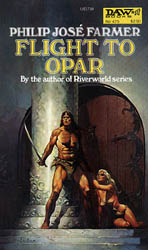
I think one big challenge was to write a book that would read like it was written in 1976, the last time a book in the series was published. I felt it was important that all three books should as much as possible have a similar feel since it was likely they'd be collected in an omnibus, which was a bit of a trick since the third book is in a different voice - Kwasin's - than the first two, which are in Hadon's viewpoint.
Fortunately, Phil gives an idea of how Kwasin sees the world in his outline to the novel. Kwasin isn't quite as smart as Hadon, and in fact, like the classic trickster archetype, he sometimes does really stupid things that cause trouble for him and those around him. In the first two books, we see Kwasin from Hadon's point of view, but Hadon doesn't really know why Kwasin acts the way he does. That is, as a lout, a bully, and a larger-than-life trickster. So the third book gets to dig into Kwasin's past a bit and also shows something of how Kwasin viewed Hadon - not with simple hatred, although there was a fair degree of that, but more so with a deep jealousy.
So there's that - establishing Kwasin's viewpoint - and then absorbing the style of the first two books, and layering on the established world-building. Of course, Phil's world-building is extremely rich.
What was it like writing in another author's world - in this case, the lost civilization of Khokarsa?
Also challenging, but I reveled in it because world-building is something I love. And I was fortunate to have Phil's extensive notes from the series: those concerning the culture and characters, as well as the maps, lexicons, and unpublished articles on the Khokarsan civilization, language, and syllabary. Regarding the latter, I was lucky to run across Phil's complete Khokarsan syllabary in his files after I'd already completed the book, so I was able to go back through it and make sure all of the names in the novel followed the rules of the syllabary. Phil had sometimes referred to what he called "interim" names in his original outline, which was his cue to go back and make sure the names corresponded with the linguistic rules for Khokarsan, which in many cases they didn't. So I was able to sync these up with the language rules.
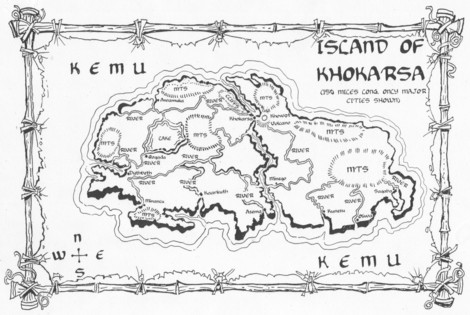
Did you find any other discrepancies in the outline?
I think it's pretty clear Phil was writing like a man possessed when he composed the original outline, and also that a little time had passed since he'd finished the first two books in the series. So he did make a few mistakes that he probably would have corrected later, like forgetting that in FLIGHT TO OPAR he'd already established some of the characters and events surrounding Kwasin's arrival in Dythbeth, the names of the king and queen there, what happened the first night he got to the city, and so on. So I had to sync up those details. Charles Berlin, the artist who rendered the new maps, was also able to correct some minor errors that first appeared in the maps in the DAW edition of HADON OF ANCIENT OPAR. These weren't Phil's mistakes, but rather errors introduced by the original cartographer, the SF artist Jack Gaughan.
In your aforementioned essay in MYTHS FOR THE MODERN AGE, you excavate some of the secret backstory of Farmer's work, just as he claimed to uncover some hidden storylines in the works of authors like Verne and Doyle. Does any of that sort of intrigue come into play in THE SONG OF KWASIN?
Sure. But I think for the most part the reader will have to carefully parse the text to pick up on it. I tried not to browbeat the reader with that sort of thing, because Phil at his most intriguing was subtle. A hint here, a taste there. It's there in plenty in the novel, but readers are going to have to draw their own road maps to it, because that's what makes reading a Farmer novel fun.
So you won't give us any hints?
Readers of Haggard should pick up on some interesting threads, beyond just the presence of Kwasin's ax, which appeared a number of Haggard stories. But that's all I'll say.
Did you have much interaction with Farmer in regards to writing the story?
As late as 1999, Phil had been thinking of wrapping up the series himself in one final novel, and as I mentioned previously, I think it disappointed him to see the series languish unfinished. So when I was in the thick of writing the novel in 2007, Bette Farmer would read installments aloud to Phil as I finished them, and she would tell me how Phil would light up at hearing of Kwasin's adventures. They both said how pleased they were and that they really enjoyed the novel, which put me over the moon.
Phil did give me some input about how he wanted the novel to wrap up. This was back in 2005, shortly after the manuscript fragment and outline had turned up. I pointed out that the original outline stops abruptly just before the conclusion, and also presents a couple of alternate courses of action for Kwasin and Awineth. When I asked Phil for his advice, he specifically told me he wanted to abandon these options for the characters, and instructed me as to how he thought the book and trilogy should drop the curtain. So I took all of that to heart and put it in the novel.

So is THE SONG OF KWASIN the ultimate culmination of the series or is there yet more of the story to tell?
KWASIN certainly stands as a conclusion to a trilogy. If any further books were to be written in the series, they would be part of a new sequence. Phil did leave a brief outline of events that would have transpired after the conclusion of the third novel, but as to whether that tale will ever be told, who knows?
When will THE SONG OF KWASIN be published?
The publisher has not officially announced the book yet, but in the Spring of 2012 Subterranean Press is slated to bring out an omnibus encompassing all three novels in the series: HADON OF ANCIENT OPAR, FLIGHT TO OPAR, and THE SONG OF KWASIN.
THE SONG OF KWASIN is not the first thing you've written set in Khokarsa. You also wrote the short story "A Kick in the Side," which was published last year in THE WORLDS OF PHILIP JOSÉ FARMER 1: Protean Dimensions. What can you tell us about this story, and what prompted you to write it?
I actually wrote that story early on when I was working on KWASIN. I had been rereading FLIGHT TO OPAR a number of times over, and each time I got to the part where Hadon's scribe Hinokly abruptly fell over the side of the ship into the sea and was never mentioned again, I couldn't help but wonder if that was the end of his story. I wrote "A Kick in the Side" to explore Hinokly's fate, and also as a tribute to anyone who's been bullied by a dullard. I admit, when I wrote it I was thinking of some of the trials and tribulations Phil went through in publishing over the years.
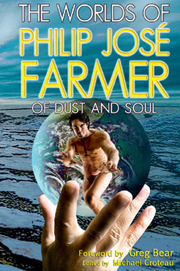
You also co-authored a 20,000-word novella with Farmer called "Kwasin and the Bear God," which will be available in the anthology THE WORLDS OF JOSÉ FARMER 2: Of Dust and Soul. Can you tell us how this story came to be written and how the novella relates to the novel?
I was in Peoria in January 2009 to celebrate Phil's 91st birthday with a small group of friends. At the end of the weekend, most everyone who'd come from out of town had left except for [PEARLS FROM PEORIA editor and Phil's friend] Paul Spiteri and me, and a few hours before my flight Bette Farmer said we could go downstairs to browse Phil's files and look for anything that might have been overlooked for possible future publication. That's when I ran across a manila folder I'd never seen before labeled "Khokarsan Lore." Paul can probably attest that I blanched when I pulled from the folder a fragmentary alternate outline to the KWASIN novel, which I'd already completed months before using Phil's partial manuscript and a different outline. But on closer examination, a large portion of the alternate outline was unusable because it contradicted already published canon from the other Khokarsa books. Another portion told the same story as Phil's original outline, the one I'd used to complete THE SONG OF KWASIN. But there were about two pages of outline that covered the story of Kwasin's adventures from the time he'd left the capital of Khokarsa to just after his arrival in the mountains near his birth city of Dythbeth. I was very excited to realize this part of the outline fit in neatly between the first and second chapters of THE SONG OF KWASIN.
So when Meteor House began their WORLDS OF PHILIP JOSÉ FARMER series of anthologies, they said they'd love to publish the unwritten story if I'd be willing to write it. I said of course I'd do it. The scene with Kwasin and the sloth of bears is probably one of the craziest, most over-the-top things I've ever written - and one of the most fun - and I have Phil to thank for that. I was also happy to be able to use a previously unpublished little piece written by Phil in the story, a Khokarsan creation myth that appears in the form of a priestess's dialogue. I think the novella, perhaps even more than the novel, captures the essence of Kwasin's trickster nature. Like HADON, it also follows the classic structure of the Campbellian hero's journey, something I realized only when I was finishing up the story. Writing about heroes brings that out subconsciously, I suppose.
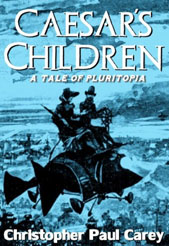
Do you have any other projects in the works?
I'm currently writing a dark fantasy novel set in the year 1888. Since it's also a historical novel, I did a tremendous amount of primary- and secondary-source research for it, although it will bend the truth in that it's a secret history. It's not a Farmerian-inspired or Wold Newton-inspired novel, but readers of Farmer might appreciate its conspiracies and intrigues. After that, depending on what else might present itself, I'm hoping to write a novel set in the "Pluritopian" world of my novelette " Caesar's Children: A Tale of Pluritopia." But one novel at a time.
More immediately, I have a story titled "Devil's Dark Harvest" in the about-to-be-released THE AVENGER: THE JUSTICE INC. FILES, edited by Joe Gentile and Howard Hopkins. It's sort of an ISLAND OF DOCTOR MOREAU-type story, which I guess is fitting, since I first became interested in fantastic literature when I read Wells. And Richard Benson - The Avenger - is, of course, a Wold Newton family member. You'll find him on the family tree in DOC SAVAGE: HIS APOCALYPTIC LIFE right next to his cousin, Paul Janus Finnegan, aka Kickaha from the World of Tiers series. That I've been fortunate enough to chronicle the story of Kwasin as well as an episode in the life of Richard Benson - both Wold Newton family members - is, I assure you, only a coincidence.
UPDATE: Chris was also interviewed by the Philip José Farmer International Bibliography in November 2011.